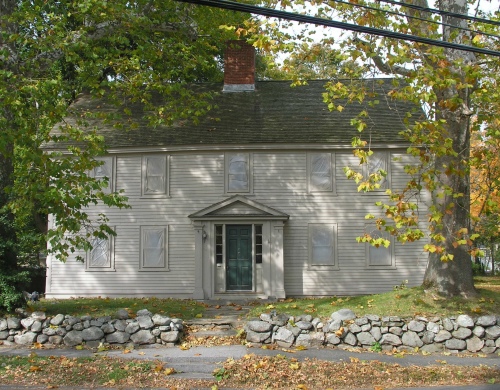Ingersoll’s Ordinary (1670)

The earliest sections of Ingersoll’s Ordinary in Danvers date to around 1670, although the building has had additions and changes over the years, most notably in 1753. In the late seventeenth century, when Danvers was known as Salem Village, this ordinary, an early type of inn and tavern, was run by Deacon Nathaniel Ingersoll. During the Salem Witch Hysteria of 1692, the ordinary was used by those involved in the examinations, held at the nearby meetinghouse. The first group of women to be accused were originally going to be examined at the ordinary, but the large crowds required the use of the meetinghouse. Tituba, a slave owned by Samuel Parris, was one of the first three people accused of practicing witchcraft during the Salem witch trials. Her husband, John Indian, also owned by Parris, worked at the ordinary. The former ordinary is now a private residence.
Is there any info on which portion of the existing house is part of the original 1670 building, and what the house looked like during the period of the trials? The house is currently for sale so I wonder how much restoration it would need to take out the “mistakes,” people made over the years.
I don’t know, but maybe you could find out by contacting the Danvers Historical Society.
Do you know how many years the building remained in the Ingersoll family?
As a child who grew up in this home, I can respond. My parents took great care in respecting the historical value of the home and also took great pride as a resident of Danvers/”Salem”. My father walked the militia trails and was on the historical society for many years. The home was sold and from what I understand, the new owners do not reside there. The entire structure remains as it was built in 1670 when we sold it. Cauldron included. Ghosts as well.
The ingersoll family purchased this house from the Pease family. This was built by my direct ggrandfather. Would love to hear more about these ghosts!
I am a 12th generation descdent from the nathaniel
I’ve been to see the house (several times), but I’d love more information about the Ingersoll family. My mother was an Ingersoll, and I know some things about the family and the Ordinary, but I’m always looking for more material. Does anyone know where the Ingersolls are buried? Anything would help…
I have recently opened a historic tavern tour business in Salem. The Ingersoll’s also financed three ordinaries/taverns in Salem Town (today’s Salem). To learn more, visit my website. http://www.1637taverntours.com
Hello, I have been doing a lot of ancestry research and I believe I am also related. My maiden name is Ingersoll. Is there a family tree for me to compare my family tree with? Thank you for your time. Peggy.
According to my research, Nathaniel’s grandnephew, Joel Ingersoll, married Mary Averill, the grandniece of Sarah Wildes, one of the first five women found guilty of witchcraft and hanged July 19, 1692, and one of those against whom Nathaniel himself testified. Joel and Mary’s son, Jonathan, is my 5th great grandfather.
Hello, I am working on my family genealogy and came across this website. Thank you for this information! Nathaniel Ingersoll is my 11th great uncle – his older brother George is my direct ancestor.
Nathaniel was the younger brother of George Ingersoll who also is my direct descendent from Richard Ingersoll who was my !0th G Grandfather.
Nathaniel is the brother of my direct ancestor, John Ingersoll. My mom’s maiden name is Ingersoll. There are Ingersoll’s buried in Lee and Westfield. My particular line ended up in Grafton in Lorain County, Ohio.